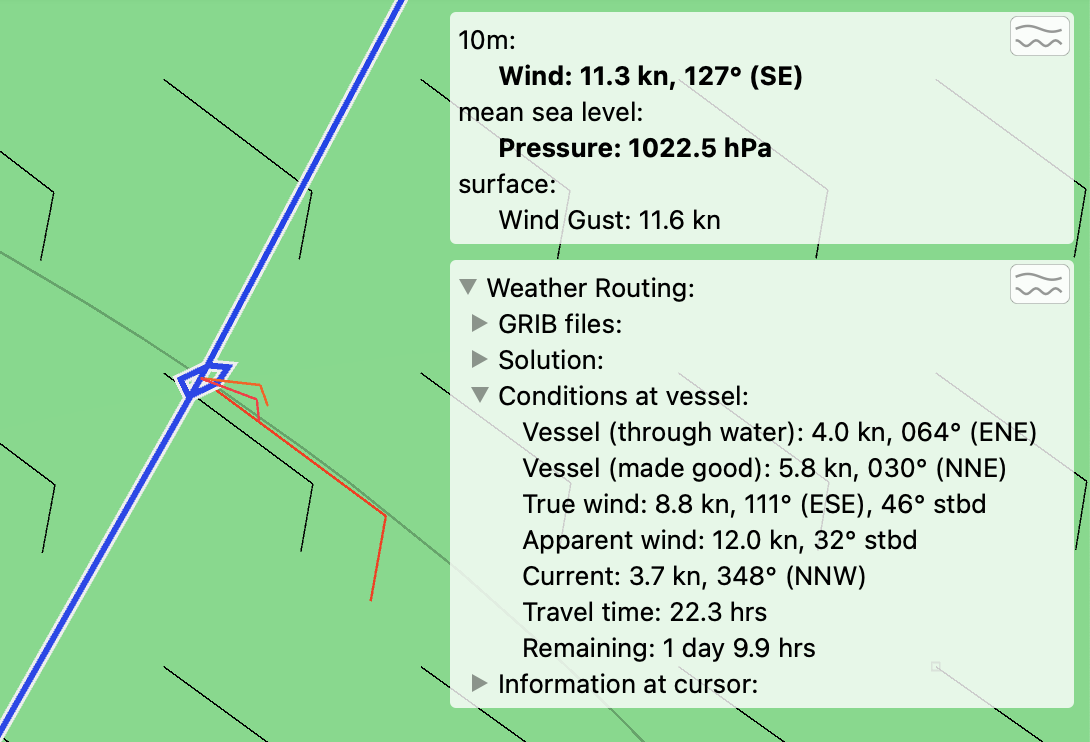This note is meant for sailors who are sailing in areas where there are strong currents.

Most people will not need to read or understand this section. It is intended for people who are detail oriented, and who want to thoroughly understand what the solver is presenting.
Ground wind, true wind and apparent wind.
When the Weather Routing Solver is accepting and accounting for currents, wind becomes more complex.
Note that there are three wind vectors that are of interest to ocean navigators: ground wind, true wind and apparent wind.
When the ground is not moving, ground wind and true wind are the same thing. When the ground is moving, as it is when a vessel is on the ocean in an area with strong currents, the ground wind and true wind are not the same. The true wind must be calculated from the ground wind and current.
Apparent wind is a pretty easy concept. Given the true wind at a vessel, and a vessels speed and direction, you can calculate the apparent wind. True wind is found when you are ‘stationary’, with respect to the water, and apparent wind is the wind you would experience, accounting for the vessels motion. Apparent wind is easily experienced by getting in a car on a calm day and driving around with your hand out the window: stop the car, and that’s true wind, drive somewhere and that’s apparent wind.
To consider the difference between ground wind and true wind, consider a sailing example: your vessel is just floating on the ocean, not moving with respect to the water around it, in an area where there is a 3 kt northward flowing current, and there is also a 3 kt south wind (from the south,) the true wind at the vessel is completely calm. The vessel is moving north at the same speed and in the same direction as the wind, and the two completely cancel out so that you don’t experience any wind.
In this example if the vessel starts motoring, it will experience an apparent wind, according to the speed and direction it is now moving. This highlights the three wind vectors: a 3 kn south ground wind, a 0 kn true wind, and then an apparent wind due to the vessels movement.
Forecast wind is ground wind.
The wind that is present in a GRIB forecast model is ground wind, or forecast wind. Many people think of the forecast wind as being true, but that is only the case when the ground is not moving. If there is a current present, you must account for it when adjusting the forecast wind to become the true wind.
Wind and the solver.
In this example, I’ve placed a boat in the gulf stream off the east coast of the USA, as shown above. In this area, the current is flowing almost due north, at over three knots. A route was generated and one of the vessel positions along the route is shown. The cursor has been placed directly on top of the vessel, so that the GRIB information shown applies for the vessel location.
There are two pieces of text information presented. On the top is the forecast (GRIB) conditions at the cursor. This is reporting the ground wind. There is also information being shown in the weather routing area for true wind and apparent wind.

Note that you only see these two text views when the Analysis Image menu is set to show the GRIB file. If you are viewing one of the other analysis images, true wind speed for example, you will not see the GRIB information. If you are studying ground wind and how it relates to true wind, changing the analysis image to its GRIB File setting is useful.
As can be seen, there are three wind vectors shown:
- ground / forecast wind: 11.3 @ 127 T
- true wind: 8.8 @ 111 T
- apparent wind: 12 @ 32 relative
The true wind shown takes the current into account. If you were on the vessel and were to look at the instruments in the cockpit, you would see the true and apparent wind values. Cockpit instruments very rarely show ground wind (perhaps never?)
(…well, the instruments would show the values above, if the forecasts were exactly correct, and the boat speed agreed with the router calculation, and the instruments were properly calibrated…)